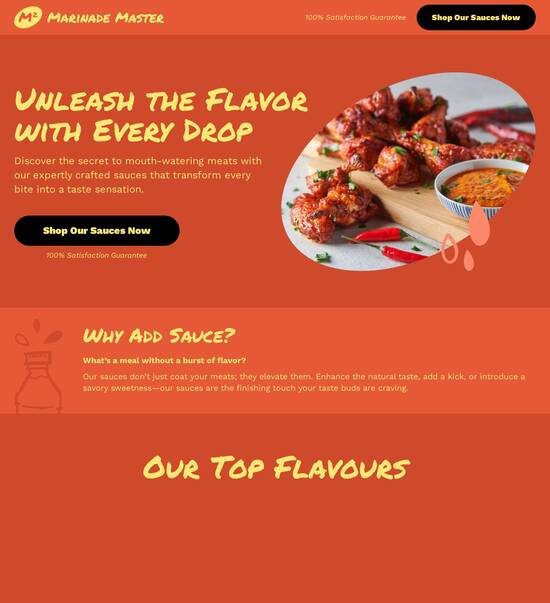
Web page template for Supply chain managers
Use TemplateAbout template
Attract clients and showcase your skills with style using our landing page templates for Supply chain managers. Let's convert those visitors into clients!
Recommended templates

Easy to build without coding
With the intuitive drag-and-drop builder, anyone on your team can create high-converting pages without any knowledge of code or design. Make enhancements to your landing page with custom widgets using Javascript, HTML/CSS, or third-party scripts.

Multiple layouts for any industry and goal
Select from 500+ landing page layouts built to boost conversions across industry-specific scenarios. Customize them by adjusting fonts, adding images, and generating on-brand content with the AI assistant. Quickly scale with Instablocks® and Global Blocks that you can save, reuse, and update globally.

Loads fast and looks polished on any device
Every template is responsive, which means they present professionally on any device and load blazingly fast with our Thor Render Engine. You can also power them up with Google AMP technology to deliver an unparalleled mobile experience and drive higher conversions.

Robust analytics & experimentation
Get real-time updates and reporting across all your devices, showing the number of visitors, conversions, cost-per-visitor, and cost-per-lead. Launch AI-powered experiments, run A/B tests, and use heatmaps to analyze user behavior, then optimize your landing page to maximize conversions.







Easy to build without coding
With the intuitive drag-and-drop builder, anyone on your team can create high-converting pages without any knowledge of code or design. Make enhancements to your landing page with custom widgets using Javascript, HTML/CSS, or third-party scripts.
Multiple layouts for any industry and goal
Select from 500+ landing page layouts built to boost conversions across industry-specific scenarios. Customize them by adjusting fonts, adding images, and generating on-brand content with the AI assistant. Quickly scale with Instablocks® and Global Blocks that you can save, reuse, and update globally.
Loads fast and looks polished on any device
Every template is responsive, which means they present professionally on any device and load blazingly fast with our Thor Render Engine.
Robust analytics & experimentation
Get real-time updates and reporting across all your devices, showing the number of visitors, conversions, cost-per-visitor, and cost-per-lead. Launch AI-powered experiments, run A/B tests, and use heatmaps to analyze user behavior, then optimize your landing page to maximize conversions.
All the features you need to build supply chain management website templates
Explore more featuresLearn how to build supply chain web design
FAQs
Leading the way in building high-performing landing pages





A guide to using Instapage for effective landing page creation
Creating high-converting landing pages is vital for digital marketing success, and Instapage is the most powerful platform to achieve just that. With its robust features tailored for marketers across various industries — including business services, tech, and education — you can quickly develop and optimize landing pages that capture leads and drive significant ROI.
Getting started with Instapage
First, sign up to Instapage and choose from over 100 customizable templates designed for diverse business needs. These templates not only save time but are also crafted for maximizing conversion rates. Here’s how to begin:
- Select a template: Browse through the categorized library and pick a layout that suits your campaign goals.
- Customize your page: Use Instablocks to drag and drop elements. Add images, text, and forms that resonate with your audience.
- Preview and publish: Always preview your landing page before publishing to ensure it looks perfect on all devices.
Optimizing for conversions
Once your page is live, it’s essential to focus on optimization for higher conversion rates. Instapage provides effective tools for this:
- A/B testing: Conduct tests on different versions of your landing page to identify which elements outperform others.
- Heatmaps: Utilize heatmaps to visualize user interactions and understand which areas attract attention or cause drop-offs.
- Analytics dashboard: Track key metrics to measure the performance of your landing pages and adjust strategies accordingly.
Personalizing user experiences
In today’s digital marketing landscape, personalization is key. Instapage allows you to dynamically change content based on audience segments:
- Dynamic text replacement: Tailor text elements based on the source of traffic to enhance relevance.
- AdMaps: Synchronize ads with landing pages to ensure a cohesive user journey, boosting engagement.
- Audience-level tracking: Measure the performance at a granular level to understand different audience segments better.
By following these steps, you can leverage Instapage to create impactful landing pages that drive conversions and maximize the return on investment for your digital marketing efforts.
Harness the potential of Instapage to elevate your marketing campaigns. Start building and optimizing today to ensure your next campaign exceeds expectations.
Are you ready to transform your marketing strategy? Join Instapage now and experience the power of high-converting landing pages.
People also ask about Web page template for Supply chain managers
Web page templates for supply chain managers: Enhancing efficiency and collaboration
Unpacking the essence of supply chain management web page templates
In the realm of supply chain management, web page templates serve as an essential tool for creating tailored online content that meets the unique needs of the industry. These templates provide a structured framework that allows supply chain professionals to streamline their operations and improve communication among stakeholders. By using these pre-designed layouts, managers can present critical information in a coherent and engaging manner, enhancing both their digital presence and operational effectiveness.
The significance of web page templates in supply chain management cannot be overstated. They simplify the process of information dissemination, helping managers convey complex data and strategies clearly and efficiently. In a profession where timely and accurate communication can significantly impact outcomes, having a well-organized digital presence is vital for success.
Improved consistency in communication among teams.
Increased operational efficiency through streamlined processes.
Enhanced visibility of performance metrics for decision-making.
Core features and capabilities of supply chain web page templates
Supply chain web page templates come with user-friendly interfaces designed specifically for executives and managers. Navigating these templates is often intuitive, allowing users to quickly locate the information they need without frustration. Additionally, browser compatibility across various devices ensures that managers can access crucial data on desktops, tablets, or smartphones, enhancing accessibility and efficiency.
Beyond user-friendly navigation, customization options are a core feature of these templates. Supply chain managers can modify colors, layouts, and branding elements to fit company standards and unique needs. By using JavaScript, templates can also incorporate interactive elements that engage users, presenting complex information in a more digestible format. Such customization capabilities allow organizations to maintain their identity while enhancing user experience.
Essential tools and integrations for supply chain web pages
One critical tool within supply chain web pages is the dynamic dashboard functionality, which provides comprehensive real-time analytics. Managers can access critical insights into operations and performance metrics, allowing for quick decision-making. Features like data visualization tools—such as Gantt charts and flowcharts—enable easy interpretation of complex data, making it straightforward to identify inefficiencies or opportunities for improvement.
Project management integration is another essential feature, offering a means to track various tasks within the supply chain. By incorporating tools like Trello or Asana, managers can oversee project timelines, allocate resources, and monitor progress efficiently. These integrations result in enhanced transparency and accountability among team members, ensuring everyone is on the same page regarding project status and milestones.
Access to real-time analytics for better operational control.
Integration with project management tools for effective resource allocation.
Enhanced collaboration features to streamline communication.
Specific applications and use cases of web page templates
Supply chain managers can utilize web page templates for various applications, one of which includes crafting strategic proposals and business cases. These templates simplify the creation of documents that require concise data presentation, helping managers articulate their visions and plans more effectively. Utilizing standardized formats leads to consistent quality in proposals, making it easier for stakeholders to digest information and support business initiatives.
Financial planning and budget management is another significant area where web templates excel. Templates can integrate budgeting tools that provide visibility over financial agendas, allowing managers to monitor budgets and expenditures in real-time. By utilizing case studies and examples within these templates, supply chain managers can further explore best practices in budget management, learning from other firms' successes and challenges.
Creating coherent strategic proposals for business initiatives.
Integrated budgeting tools for effective financial oversight.
Showcasing case studies to learn from industry practices.
The role of AI and digital transformation in supply chain management
The integration of artificial intelligence within supply chain web page templates enhances data analysis capabilities and decision-making processes. AI-driven analytics tools allow for the identification of trends and patterns that may not be immediately evident, providing managers with actionable insights that can propel efficiency and productivity. For example, predictive analytics can forecast demand levels, helping managers prepare their operations accordingly.
Moreover, adapting to digital transformation trends is crucial for supply chain managers. Templates that evolve alongside technological advancements help employees remain competitive in an ever-changing market. Utilizing contemporary practices, such as cloud-based collaborations or automated reporting, is essential for staying agile and responsive within the industry.
Legal and cybersecurity considerations
Building trust among stakeholders hinges on robust cybersecurity measures. Web page templates can incorporate best practices to safeguard sensitive data, ensuring secure access and maintaining the integrity of information presented. Implementing tools for cyber risk management is particularly important in project presentations, where sensitive business strategies might be shared.
Another critical aspect is compliance and permissions management. Understanding the need for permission-based access is vital for protecting sensitive reports and data. Web templates can enforce these permissions, maintaining compliance with legal standards and allowing users to manage who has access to specific documents or data sets.
Implementing strong cybersecurity measures for data protection.
Using permission-based access to safeguard sensitive information.
Maintaining compliance with relevant legal standards.
Streamlining operations and efficiency
Optimizing supply chain operations is a primary focus for many managers, and web page templates play a crucial role in this effort. By incorporating features like task automation and workflow management tools, templates can enhance operational efficiency. A well-designed template enables managers to track processes in real-time and makes it easier to identify bottlenecks before they escalate.
Additionally, focusing on user experience and customer journey mapping can significantly improve engagement. Templates can help supply chain professionals create more intuitive web pages that guide users seamlessly through the information journey, whether they are clients needing product information or team members collaborating on projects. Effective mapping techniques can reveal pain points in the customer journey, enabling teams to fine-tune processes and enhance satisfaction.
Using automation tools to streamline workflows and operations.
Implementing real-time tracking features for process oversight.
Enhancing user experience through effective journey mapping.
Practical guidance for implementation and utilization
Implementing web templates within existing supply chain systems can initially seem daunting. However, following best practices can facilitate a smoother transition. Assessing the current infrastructure and determining the necessary modifications pave the way for effective deployment. It is also essential to customize templates to suit the specific needs of the industry, whether that be a focus on medical logistics, financial transactions, or startup management.
Real-world case studies can provide invaluable insights into how companies have successfully navigated this transition. Studying these examples illustrates the effectiveness of using web page templates, revealing the improvements in efficiency and growth that other supply chain managers have experienced. By analyzing these results, businesses can better understand the tangible benefits that come from utilizing structured web solutions.
Conducting thorough assessments of current systems before implementing templates.
Customizing templates to meet specific industry requirements.
Leveraging success stories to inform best implementation practices.
Navigating access and pricing models
Understanding the pricing structures for web page template solutions is essential for businesses to make informed decisions. Various models exist, from subscription-based services to one-time purchases. Each structure has its benefits and potential drawbacks, making it crucial for supply chain managers to analyze what aligns best with their organizational needs and budget constraints.
Additionally, maximizing return on investment (ROI) with web templates requires strategic planning. Supply chain managers should monitor template performance and ensure they are aligned with organizational goals. By employing metrics that measure effectiveness, managers can continuously evaluate the impact of their chosen templates on operational efficiency and customer engagement.
Exploring different pricing models to find the best fit for needs.
Using ROI metrics to assess template effectiveness.
Strategies for ongoing evaluation and optimization.
Ready to skyrocket conversions?
Supercharge your ad campaigns with high-performing landing pages
Get started














